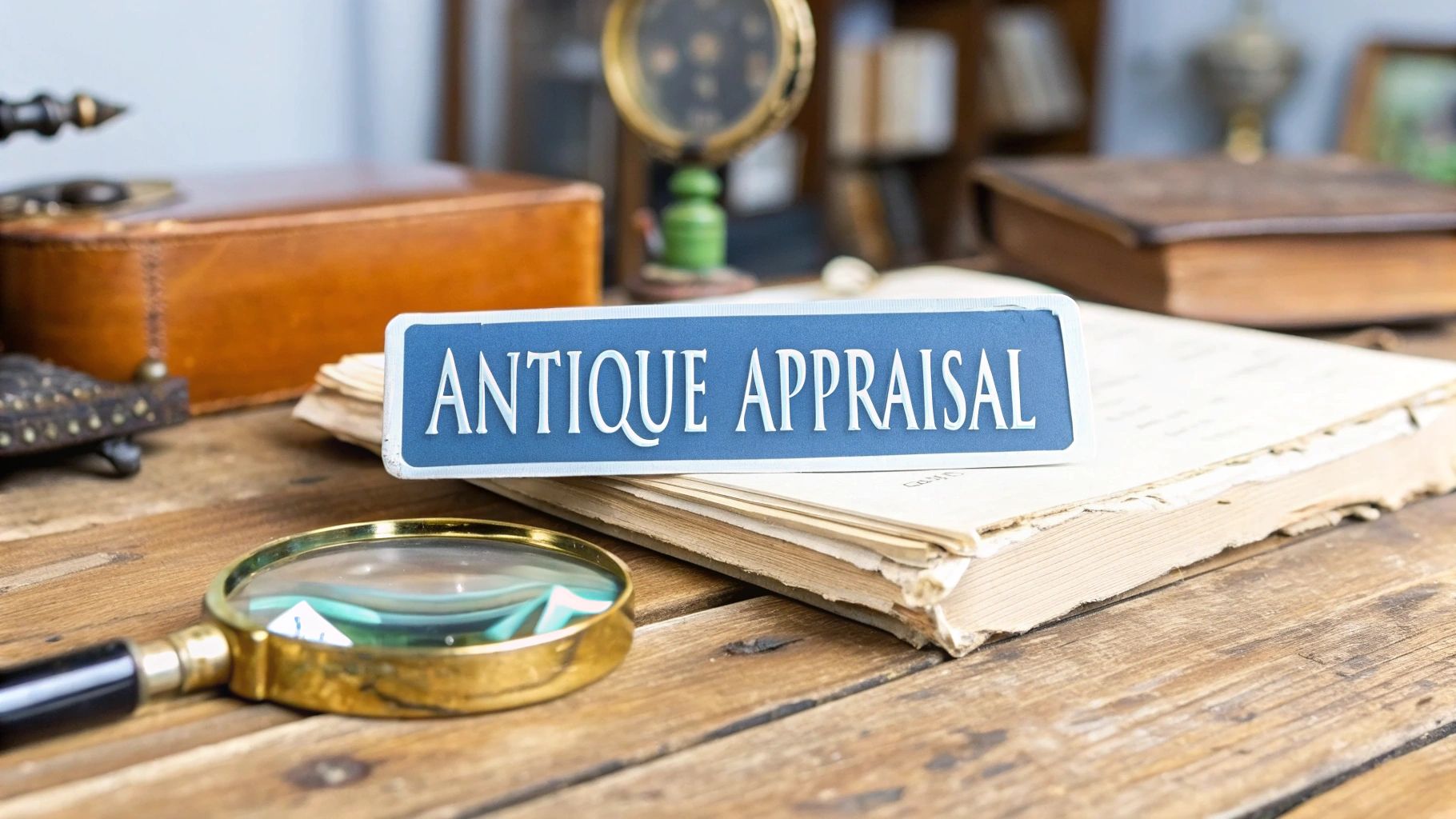Ever wonder what that old family heirloom is really worth? An appraisal for antiques is how you find out. It's not just a quick guess at a price tag; it's a formal, deeply researched opinion of an object's value, put together by a qualified expert. Think of it as a detailed biography of your item, one that establishes its worth for important things like insurance, selling, or estate planning.
What an Appraisal for Antiques Really Means
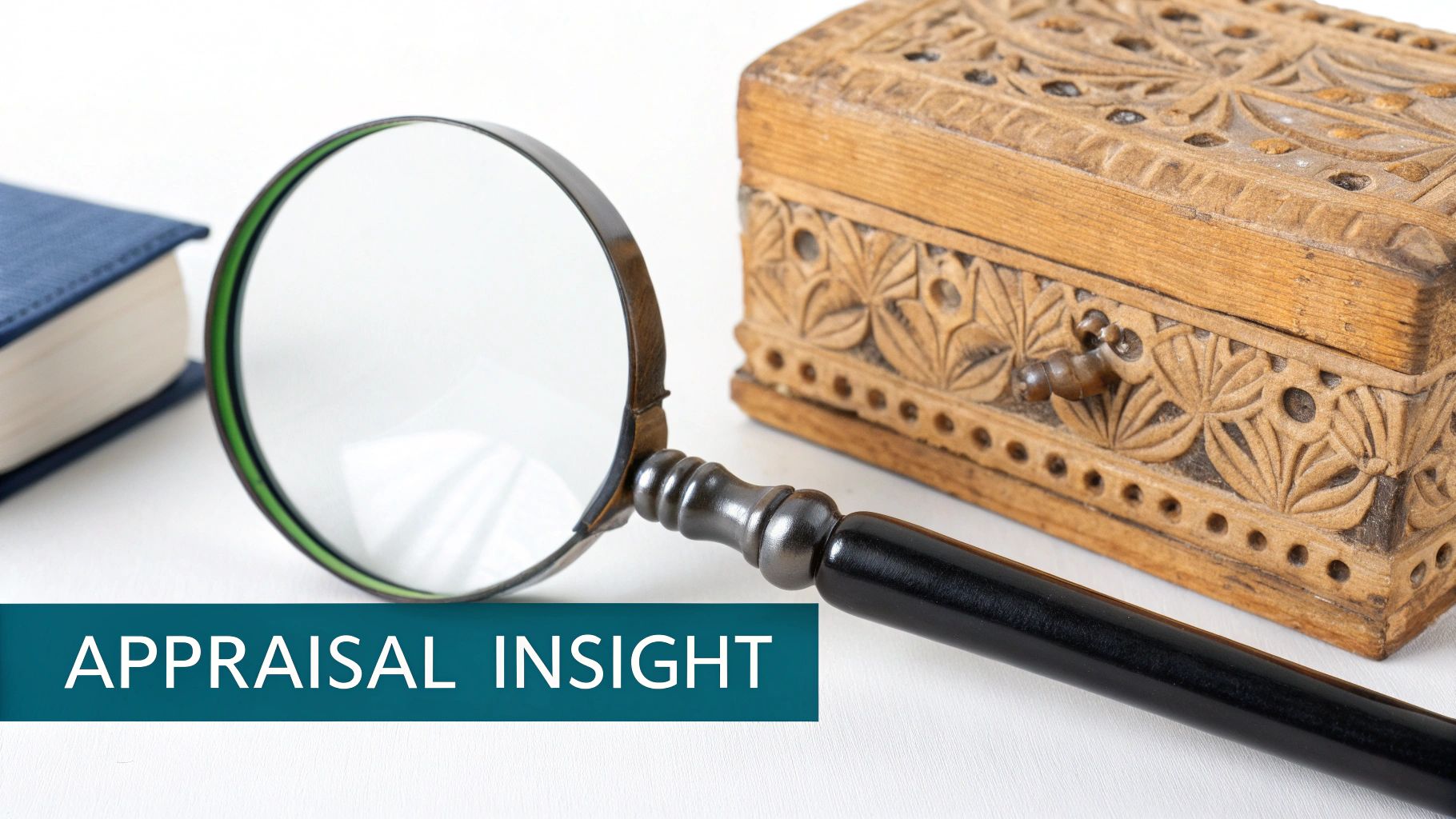
Before we get into the nuts and bolts, let's be clear about what an appraisal actually is. It's far more than a simple price; it’s the story of your item, backed by solid research and a clear-eyed look at the current market. This professional assessment has a specific goal, whether you're trying to insure a precious vase, sell a vintage watch, or divide assets in an estate.
The value isn't just pulled out of thin air. It’s a carefully calculated figure based on proven methods and hard evidence.
Beyond a Simple Price Check
The biggest difference between a professional appraisal and a casual estimate is that an appraisal gives you a defensible opinion of value. This is critical for any formal situation. It’s a world away from a quick quote you might get at a flea market or from an online calculator. A proper appraisal document carries weight and authority.
For instance, an insurance company needs a detailed report to write an accurate policy. A serious buyer will feel much more confident making an offer when they see a formal valuation. This process always involves a few key steps:
- Detailed Examination: The appraiser gets hands-on, inspecting the item for maker’s marks, checking its condition, and identifying the materials and craftsmanship.
- Thorough Research: Next comes the detective work. They dig into the item’s history, its artist or manufacturer, and its provenance (the chain of ownership).
- Market Analysis: Finally, the expert compares your piece to recent, documented sales of similar objects at auctions and through private dealers.
This painstaking approach makes sure the final number truly reflects where your item stands in today's market. And what a market it is. The global antiques and collectibles space is enormous, valued at an estimated USD 238.1 billion and expected to climb to USD 402.9 billion by 2034. A good appraisal helps you make sense of this massive, complex world.
Setting the Foundation for Smart Decisions
At the end of the day, a professional appraisal for antiques gives you the knowledge to make smart, informed choices. It helps you separate emotional attachment from what is fair market value—a critical distinction for any transaction. Understanding what determines fair market value is the first step every owner should take.
This knowledge is your best protection. It stops you from unknowingly selling a treasure for a fraction of its worth or, just as bad, being underinsured when disaster strikes.
By investing in an appraisal, you are not just discovering a price. You are documenting your item's legacy, securing its financial worth, and empowering yourself with the facts needed to manage your assets wisely.
Decoding the Five Factors of Antique Value
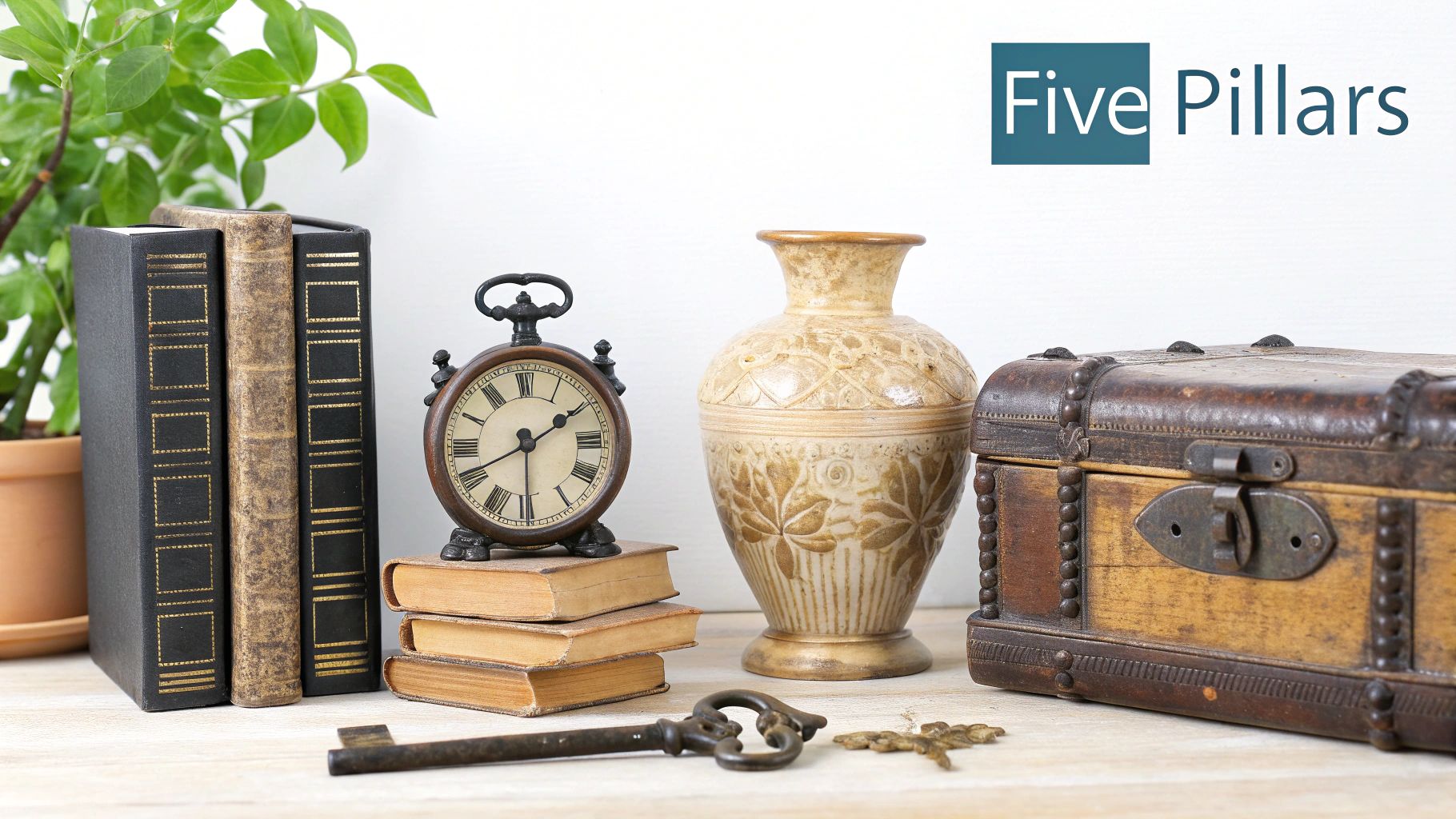
Figuring out what an antique is worth isn't some kind of mysterious art—it's a methodical process. Think of it like a chef building a masterpiece dish. The final taste depends on the quality and combination of a few key ingredients. For an appraiser, those ingredients are five core factors that, together, tell the full story of an item's value.
Getting a handle on these pillars—Rarity, Provenance, Condition, Authenticity, and Market Desirability—is your first step toward seeing an item through an appraiser's eyes. It helps you move past sentimental value and start thinking objectively. Let's break down what each one really means.
Factor 1: Rarity
This one seems pretty simple on the surface: how many of them are out there? An object that was mass-produced by the thousands, like a common piece of Depression glass, is naturally going to be less valuable than a handmade vase by a famous artisan who only made a handful.
But here’s the catch: rarity alone doesn’t automatically mean value. An item can be the only one of its kind in the world, but if nobody wants it, its rarity is just an interesting fact, not a financial asset. Real value happens when rarity meets demand.
For instance, a limited-run porcelain figurine from a well-known maker is rare. If collectors are actively hunting for that specific series, its value can skyrocket. The magic ingredient is desirable rarity, where a limited supply runs into a hungry market.
Factor 2: Provenance
Provenance is simply the item's life story—a documented history of who owned it and where it's been. A good story can send an item's value through the roof. Think of it as an object's resume or pedigree.
A plain wooden chair might be worth $100 on its own. But if you have letters, old photos, or a receipt proving that same chair once belonged to a historical figure, its value could leap to $10,000 or more. The chair didn't change, but its story did.
A documented provenance acts as a value multiplier. On the flip side, a story based only on family lore without proof, or a gap in the ownership history, can drop an item’s value right back down to what the materials and craftsmanship alone are worth.
Here’s the kind of proof that builds a strong provenance:
- Original Bill of Sale: This is the gold standard, directly connecting the piece to its first owner.
- Letters or Diaries: A mention of the item in old correspondence gives it powerful, personal context.
- Old Photographs: Pictures showing the item in its original home are fantastic visual proof.
- Previous Appraisal Documents: A paper trail of past valuations shows it has been recognized as a significant piece over time.
Factor 3: Condition
Condition is all about the physical shape the antique is in. An appraiser will go over every inch, looking for damage, repairs, and general wear and tear. As you’d expect, an item in original, near-perfect condition will always bring the highest price.
Obvious flaws like cracks, big chips, stains, or missing pieces will almost always lower the value. But not all signs of age are bad. A 200-year-old table is supposed to show some wear. That gentle aging, what we call patina, can actually prove its age and history, making it more desirable.
Be careful, though. An overzealous restoration or a harsh cleaning can be a disaster. Stripping off an old finish might seem like a good idea, but you're really erasing decades of history and authenticity. Often, an untouched piece with a few dings is worth far more.
Factor 4: Authenticity
Is the item the real deal? Authenticity is the absolute bedrock of any appraisal for antiques. The appraiser's job is to confirm that the piece isn't a clever reproduction, an outright forgery, or something from a later period being passed off as older.
Experts have a trained eye for the clues that verify authenticity:
- Maker's Marks: They check signatures, stamps, and labels to make sure they match the known marks from that creator and time period.
- Materials and Construction: Are the wood, metal, and joinery techniques right for the era? A 17th-century chest won't be held together with modern screws.
- Style and Form: The design itself has to fit the artistic conventions of when and where it was supposedly made.
If a piece is exposed as a fake or a later copy, its value as an antique plummets to almost nothing, no matter how beautiful or well-made it is.
Factor 5: Market Desirability
At the end of the day, an antique is only worth what someone is willing to pay for it right now. Market desirability—or simple demand—is all about current collecting trends. Tastes are always changing, and what was all the rage 30 years ago might leave today’s buyers cold.
An appraiser digs into recent auction results and private sales for similar items to get a pulse on the current market. For example, mid-century modern furniture from designers like Eames is incredibly popular right now, which drives prices way up. On the other hand, a lot of heavy, ornate Victorian furniture has fallen out of fashion, causing its value to drop. This final factor is what connects all the others to a real-world dollar amount.
Key Factors Influencing Antique Valuation
To pull it all together, here is a quick summary of how these critical elements work in the real world. An appraiser weighs each of these to arrive at a final valuation.
| Valuation Factor | Description | High-Value Indicator Example | Low-Value Indicator Example |
|---|---|---|---|
| Rarity | The scarcity or uniqueness of an item. | A limited-edition Tiffany lamp with only 50 ever made. | A mass-produced "Carnival" glass bowl from the 1920s. |
| Provenance | The documented history and ownership of the item. | A desk with a bill of sale showing it was owned by a U.S. President. | A sword claimed to be from the Civil War with no documentation. |
| Condition | The physical state, including wear, damage, and repairs. | A 19th-century porcelain vase with no chips, cracks, or fading. | An antique rocking chair with a broken runner and replaced parts. |
| Authenticity | Verification that the item is genuine and not a reproduction. | A painting with a signature authenticated by a recognized expert. | A piece of silver with a maker's mark known to be used on forgeries. |
| Market Desirability | The current demand for the item among collectors and buyers. | An original Eames lounge chair, highly sought after today. | An ornate, heavy Victorian sideboard, which is currently out of style. |
Understanding these five pillars doesn't just help you talk to an appraiser—it gives you the framework to start evaluating the potential of any antique you come across.
Choosing the Right Appraisal for Your Needs
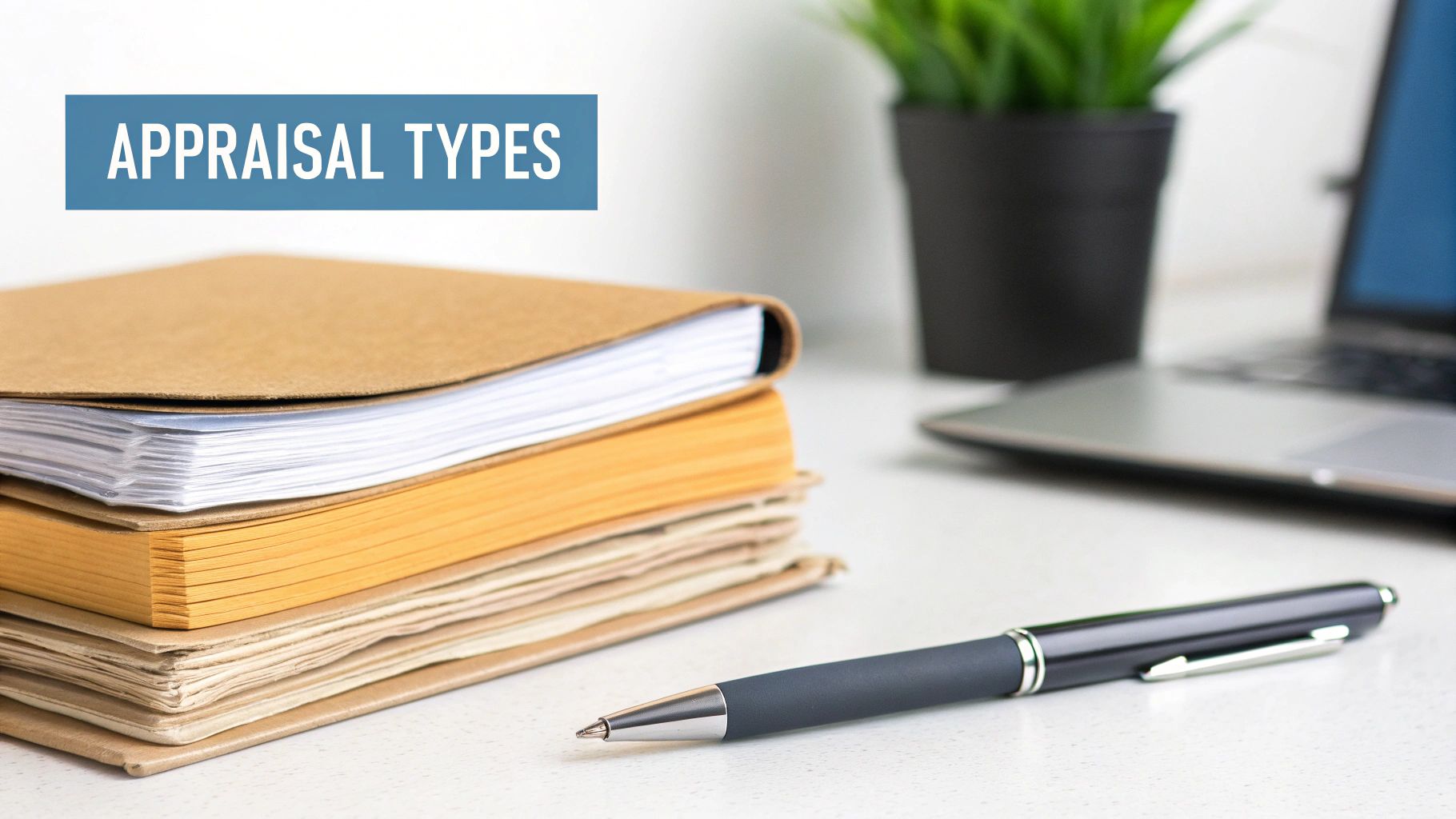
When it comes to appraisals, one size definitely does not fit all. Think of it like seeing a doctor; you wouldn't go to a surgeon for a common cold. Getting the right type of appraisal for antiques is just as specific. Picking the correct one from the start is the key to getting a document that actually helps you, saving you a world of trouble down the line.
The first question any good appraiser will ask is, "What do you need this for?" Your answer changes everything. An appraisal for insurance is a completely different beast than one for selling an item or settling an estate. Being clear about your goal ensures the final report is fit for purpose.
Generally, you'll encounter three main types of appraisals, each looking at value through a unique lens. Let's break them down so you know exactly what to ask for.
Insurance Appraisals for Replacement Value
Picture this: your treasured antique grandfather clock is tragically lost in a house fire. An insurance appraisal is designed to answer one crucial question: How much would it cost to go out and buy a nearly identical clock—same maker, similar age, and condition—from a retail dealer today?
This figure is called Replacement Value, and it's almost always the highest valuation you'll see. Why? Because it reflects the full retail price, including the dealer's markup and the effort required to find such a specific piece. It’s not about what you could sell it for, but what it would cost to make yourself whole again.
- Purpose: To get the right amount of insurance coverage for your valuables.
- Value Type: Retail Replacement Value (RRV).
- Typical Outcome: The highest value, reflecting the cost of buying a replacement on the open market.
This is the number your insurance company needs to see to write a policy that truly protects you from loss, theft, or damage.
Fair Market Value for Sales and Estates
Now, let's say you're looking to sell an antique, donate it, or handle the division of property for an estate. For these situations, you'll need its Fair Market Value (FMV). This is by far the most common type of appraisal.
Fair Market Value estimates the price a willing buyer would pay a willing seller, assuming both people are reasonably informed about the item. It’s a realistic snapshot of what your piece could fetch in the current market, perhaps at a well-advertised auction or through a private sale.
This value is the gold standard for tax situations, like calculating estate taxes or figuring out a charitable donation. The IRS relies on FMV because it provides an objective, defensible number for these kinds of transactions.
With the boom in sustainable shopping, the secondary market for vintage goods is thriving. This market was recently valued at an impressive USD 75 billion and is expected to double to USD 150 billion by 2032. Understanding your item's FMV is your ticket to confidently navigating this exciting space. You can dig deeper into these market dynamics over at Asheford.com.
Liquidation Value for Quick Sales
Sometimes, you just need to sell something fast. A Liquidation Value appraisal tells you what an item would likely bring in a forced sale situation—think of an estate sale that has to be wrapped up by the end of the weekend, or a quick-consignment auction.
Because speed is the priority, this valuation is usually the lowest. It's a "cash-now" price that doesn't have the luxury of waiting for the perfect buyer or ideal market conditions to come along.
Of course, each type of appraisal comes with its own costs. To get a clear idea of what to budget for, take a look at our detailed guide on antique appraisal costs. Knowing what to expect financially will help you make the best choice for your situation.
How to Find a Qualified Antique Appraiser
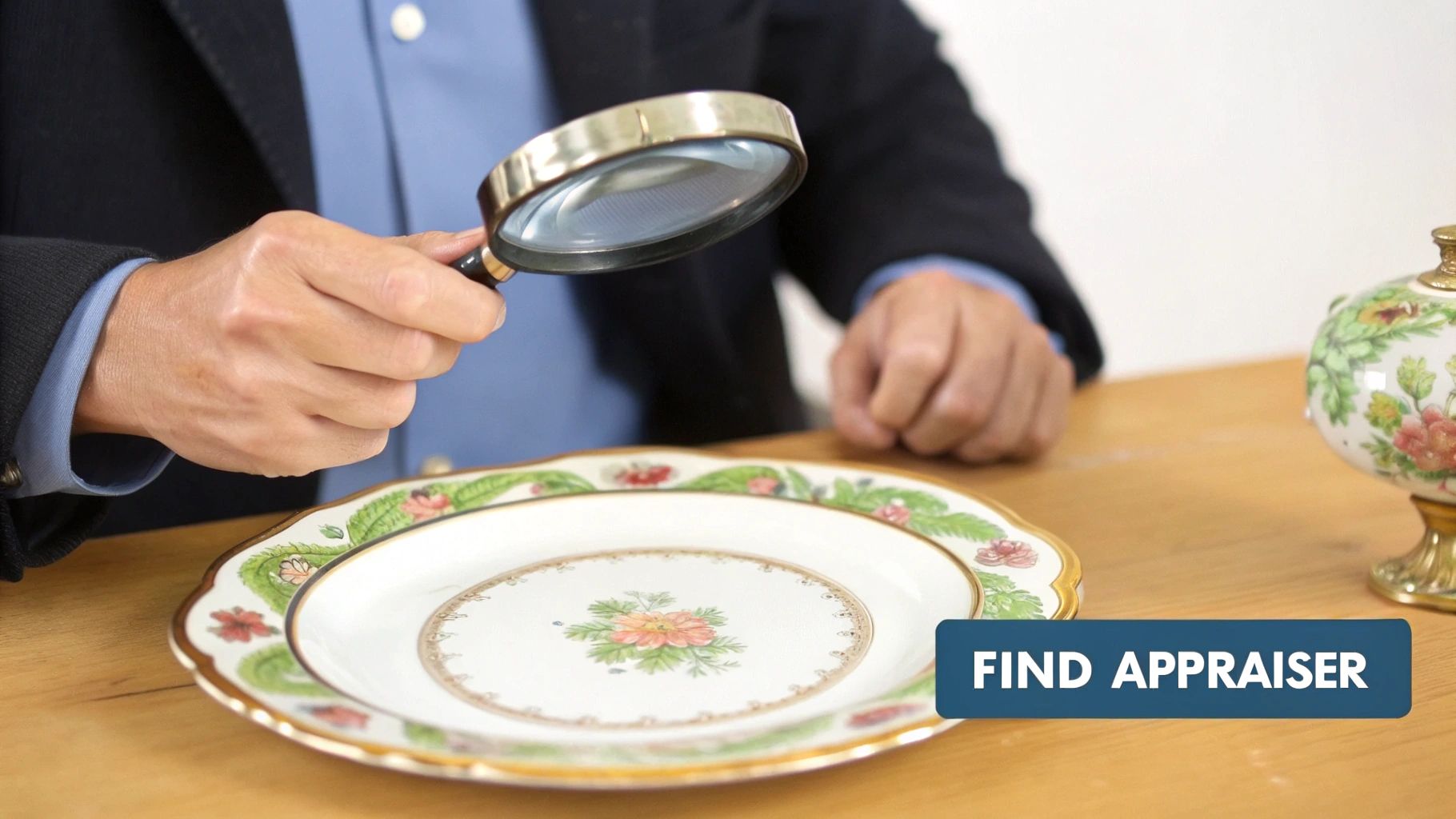
Knowing what goes into an antique valuation is a great start, but finding the right professional to actually do the appraisal is where the real work begins. The right appraiser is much more than just a pricing guru; they're part detective, part historian, and a trusted advisor all rolled into one. Your mission is to find someone whose only goal is to give you an accurate, unbiased opinion of your item's value.
Picking the wrong person can lead to a wildly inaccurate appraisal, which can cost you real money and peace of mind. A true professional brings not just their deep knowledge but also a strict code of ethics to the job. Honestly, this is the most critical part of the whole process, so it really pays to be thorough and ask the right questions from the get-go.
Start with Professional Organizations
The best place to kick off your search is with the major professional appraisal organizations. These groups are the gatekeepers of the industry. They make sure their members meet tough educational standards, follow a strict ethical code, and stay sharp with continuing education. This vetting process does a ton of the legwork for you.
Think of these organizations as the "board certification" for the appraisal world. The two most respected in the United States are:
- Appraisers Association of America (AAA): This group certifies appraisers in over 100 different specialties, covering everything from fine art to antique furniture.
- International Society of Appraisers (ISA): The ISA is known for its rigorous training and credentialing programs, making sure its members are masters of appraisal theory and practice.
Their online directories are a fantastic starting point. You can filter by specialty and location, which makes it much easier to find an expert who actually knows about your specific item, whether it's vintage jewelry or an 18th-century clock. For more tips on narrowing down your search, take a look at our guide on finding an antique appraisal near you.
Key Questions to Ask Every Potential Appraiser
Once you've got a shortlist of candidates, it's time to interview them. A quick phone call can reveal a lot. Be direct and have a few essential questions ready to make sure you’re hiring a genuine pro.
A reputable appraiser will always be open and transparent about their qualifications, methods, and fees. If you sense any defensiveness or get vague answers, that’s a huge red flag. Just walk away and find someone else.
Here’s what you absolutely must ask:
- What is your specific area of specialization? A generalist might be okay for some items, but if you have a rare Japanese print, you need an expert in Asian art, not a furniture specialist.
- How many years have you been appraising this type of item? Experience is everything. You want someone with a proven track record handling items just like yours.
- Are you certified by a major organization like the AAA or ISA? This is your confirmation that they're held to high professional standards.
- How do you charge for your services? This is a crucial question, and the answer says a lot about their ethics.
Understanding Fees and Avoiding Conflicts of Interest
A professional appraiser will almost always charge a flat hourly rate or a fixed fee for the entire project. This structure is important because it ensures their payment isn't tied to the value of your antique, which keeps their opinion objective and unbiased.
Here's a critical warning sign: Never, ever work with an appraiser who wants to charge a percentage of the antique's value. This creates a massive conflict of interest. An appraiser who stands to make more money from a higher valuation has an incentive to inflate the numbers, which can create serious problems for you, especially for insurance or tax purposes.
Similarly, be very cautious if an appraiser immediately offers to buy the item from you. Their job is to provide an impartial valuation, not to acquire your property.
Preparing for Your Appraisal Appointment
Once you've chosen your appraiser, a little prep work can make the whole process smoother and more accurate. The more information you can give the expert, the better job they can do.
Before the appointment, try to gather the following:
- All Supporting Documents: Dig up any old receipts, family letters, previous appraisals, or certificates of authenticity you might have.
- Known History (Provenance): Jot down everything you know about the item’s past. How did your family get it? Where did it come from? Even old family stories can hold valuable clues.
- Do Not Over-Clean: It's tempting, but resist the urge to polish or restore the item yourself. An appraiser needs to see it in its current, "as-is" state. Aggressive cleaning can actually strip away valuable patina and lower its worth.
By doing your homework and partnering with a qualified professional, you can be confident that the final appraisal for antiques you receive is more than just a number—it's a credible, well-researched document you can trust.
How Technology Is Reshaping Appraisals
You might think the antiques world is all about the past, but it's actually leaning hard into the future. Getting an appraisal for antiques isn't just about a dusty magnifying glass anymore. Thanks to some seriously smart tech, the whole process is becoming more accurate, open, and easier for everyone involved.
This isn't just a small shift, either. It’s part of a huge wave. The online market for reselling furniture alone hit $34 billion and is expected to jump to $56 billion by 2030. That tells you people are getting very comfortable buying and selling significant pieces online. You can learn more about how technology is kicking off a new era for antiques over on ronati.com.
Data-Driven Valuations with AI
One of the biggest game-changers is artificial intelligence. Think of AI as a research assistant on steroids. It can instantly comb through massive databases of auction results, private sales records, and market trends—a job that would take a human appraiser weeks, if not months.
This lets an appraiser spot subtle market shifts almost as they happen. For instance, an AI can analyze thousands of sales to see if demand for a specific style of 19th-century silver is creeping up or starting to cool down. This data-first approach takes a lot of the guesswork out of the equation, leading to valuations that are based on what the market is actually doing right now.
Technology is not replacing the appraiser's expert eye; it's enhancing it. By handling the heavy lifting of data analysis, these tools free up experts to focus on the nuanced details of an item—its condition, craftsmanship, and unique story.
The Rise of Digital Provenance
Another piece of tech shaking things up is blockchain. It might sound complicated, but its job here is simple: to create an un-fakable record of ownership. Every time an antique is sold, appraised, or restored, a new digital "block" of information is added to its permanent history.
This creates a secure and verifiable provenance that's nearly impossible to tamper with. For both buyers and sellers, this provides a whole new level of confidence. Having this kind of digital history helps to:
- Combat Fraud: It makes it incredibly difficult to pass off forgeries or items with a shady past.
- Build Trust: Buyers can feel secure in the item’s backstory, which often means they're willing to pay more for it.
- Preserve History: An item's entire journey gets locked in, safely documented for future owners and historians.
Finally, things like high-resolution digital photography and 3D scanning are making remote appraisals a real option. An expert can now inspect the tiny details of a maker's mark or faint cracks in a vase from the other side of the globe. This makes the whole process more convenient without losing out on the critical details that determine value.
Common Appraisal Mistakes You Need to Avoid
https://www.youtube.com/embed/w-S_Y32DWfM
Getting an antique appraised is exciting, but a few common missteps can easily lead to an inaccurate valuation or, even worse, permanent damage to your piece. Knowing what these pitfalls are ahead of time is the best way to protect your item's financial and historical value.
One of the biggest—and most heartbreaking—mistakes is over-cleaning. It’s a completely natural instinct to want your item to look its absolute best. The problem is, what you see as tarnish or grime, an appraiser sees as patina. Patina is the beautiful, subtle aging that tells an object’s story.
If you aggressively polish an old silver teapot or sand down and refinish a wooden chest, you’re literally wiping away the evidence of its history. This can absolutely slash its value in an instant.
An expert appraiser wants to see an item exactly as it is, warts and all. A well-intentioned but overly enthusiastic cleaning can erase decades of history, and a huge chunk of the item's market value right along with it. Always wait for a professional to advise you on any cleaning or restoration.
Letting Emotions Cloud Judgment
It's completely understandable to let sentimental value and family stories shape your expectations. That old desk your great-grandfather used every day is priceless to you, but an appraiser has to stick to the objective, market-based facts.
A common slip-up is treating unverified family lore as gospel. For example, a story that a Civil War sword was used at the Battle of Gettysburg is just a story without any documentation to back it up. An appraiser will value it based on its maker's mark, its condition, and any verifiable history—not on cherished family tales. It helps to separate your emotional attachment from the item's market reality to get a clear picture.
Another critical error is not getting the right person for the job. You wouldn't ask a mechanic to fix your plumbing, and the same thinking applies here.
- Choosing a Generalist for a Specialist's Job: A general appraiser is perfect for a mixed collection, but they might not catch the tiny details that make a niche item valuable. If you have rare Japanese ceramics, you need an expert in Asian pottery, not a generalist who mostly deals in European furniture.
- Confusing a Dealer with an Appraiser: An antique dealer's business is to buy low and sell high. While many are incredibly knowledgeable, their valuation could be colored by their interest in buying the item from you. A certified appraiser, on the other hand, has one job: to give you an unbiased, objective valuation.
Ignoring the Importance of Preparation
Finally, a simple lack of prep can really hold back the appraisal process. Showing up to an appointment or having an appraiser visit your home without gathering your documents is a huge missed opportunity.
Pull together any old receipts, letters that mention the item, or even old photos of it in your family's home. These things help place the piece in a historical context. Also, make sure your items are easy to get to for an in-home visit. A few minutes of prep work helps the appraiser build a much richer, more accurate story of your antique and its true value.
Frequently Asked Questions About Antique Appraisals
It's totally normal to have questions when you're diving into the world of antique appraisals. Getting straight answers is the best way to feel good about the whole process. Let's walk through some of the most common questions I hear all the time.
How Much Does an Antique Appraisal Cost?
The price tag on an appraisal for antiques really boils down to the appraiser's experience and where you're located. Most seasoned pros charge by the hour, and you can generally expect that rate to be somewhere between $150 and $400. For a whole house or a big collection, some might offer a flat project fee.
Whatever you do, always get a written quote before they start. You don't want any surprises later.
A huge red flag: any appraiser who suggests charging a percentage of your item's value. That's a serious conflict of interest and a major ethical no-no, since it gives them a reason to pump up the numbers.
Are Online Appraisals Reliable?
Online appraisals can be a pretty handy and cheap way to get a ballpark figure for what something's worth. They're perfect for scratching a curiosity itch or for items you suspect aren't incredibly valuable, where a full-blown, in-person appraisal feels like overkill.
But you have to understand their limits. Someone looking at a photo can't feel the weight of an object, spot a subtle hairline crack, or find a tiny, hidden maker's mark. If you need an appraisal for something official like insurance, or if you think you have a real treasure on your hands, you absolutely need an in-person inspection. There's just no substitute for a hands-on look.
What Is the Difference Between an Appraisal and an Auction Estimate?
This one trips a lot of people up, but the difference is huge and incredibly important.
- An Appraisal: Think of this as a formal, legally recognized document. It's a carefully researched opinion of value for a specific reason—like insurance coverage or settling an estate—and it comes with a detailed written report to back it all up.
- An Auction Estimate: This is just the price range an auction house thinks your item might fetch on a good day. It's really more of a marketing guess to get bidders excited, not a formal valuation. The actual selling price could be way higher or way lower.
Here's an easy way to remember it: an appraisal is like a thoroughly researched biography, while an auction estimate is more like a promotional flyer.
Do I Need an Appraisal Before Selling My Antique?
It's not required by law, but getting an independent appraisal before you sell is one of the smartest things you can do. It gives you an objective Fair Market Value, and that number becomes your best friend during negotiations.
Having that official report in hand does two key things for you. First, it protects you from accidentally letting go of a family heirloom for pennies on the dollar. Second, it lets you walk into a conversation with a dealer or auction house with total confidence, because you have the facts to support your asking price. It completely levels the playing field.
Ready to uncover the story behind your own treasures? With Curio, you get an antique expert in your pocket. Snap a photo to instantly identify items, learn their history, and get a quick appraisal. Download the app today and let your antiques tell their story. Learn more at https://www.curio.app.
